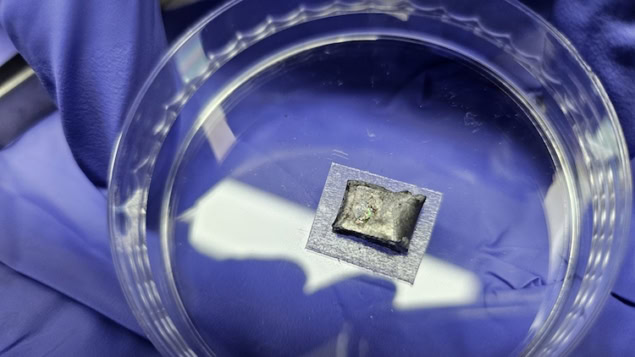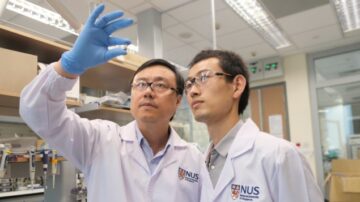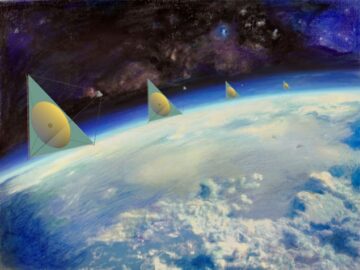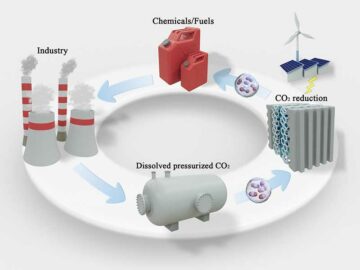
The usual way of manufacturing synthetic diamonds involves applying huge pressures to carbon at high temperatures. Now, however, researchers at the Institute for Basic Science (IBS) in Korea have shown that while high temperatures are still a prerequisite, it is possible to make polycrystalline diamond film at standard pressures. The new technique could revolutionize diamond manufacturing, they say.
Natural diamonds form over billions of years in the Earth’s upper mantle at temperatures of between 900 and 1400 °C and pressures of 5–6 gigapascals (GPa). For the most part, the manufacturing processes used to make most synthetic diamonds mimic these conditions. In the 1950s, for example, scientists at General Electric in the US developed a way to synthesize diamonds in the laboratory using molten iron sulphide at around 7 GPa and 1600 °C. Although other researchers have since refined this technique (and developed an alternative known as chemical vapour deposition for making high-quality diamonds), diamond manufacturing largely still depends on liquid metals at high pressures and temperatures (HPHT).
A team led by Rodney Ruoff has now turned this convention on its head by making a polycrystalline diamond film using liquid metal at just 1 atmosphere of pressure and 1025 °C. When Ruoff and colleagues exposed a liquid alloy of gallium, iron, silicon and nickel to a mix of methane and hydrogen, they observed diamond growing in the subsurface of the liquid metal. The team attribute this effect to the catalytic activation of methane and the diffusion of carbons atoms in the subsurface region.
No seed particles
Unusually, the first diamond crystals in the IBS experiment began to form (or nucleate) without seed particles, which are prerequisites for conventional HPHT and chemical vapour deposition techniques. The individual crystals later merged into a film that is easy to detach and transfer to other substrates.
To investigate the nucleation process further, the team used high-resolution transmission electron microscopy (TEM) to capture cross-sections of the diamond film. These TEM images showed that carbon builds up in the liquid metal subsurface until it reaches supersaturated levels. This, according to the researchers, is likely what leads to the nucleation and growth of the diamonds.
Separately, synchrotron X-ray diffraction measurements revealed that although the diamond formed via this method was highly pure, it contained some silicon atoms situated between two unoccupied sites in the diamond lattice of carbon atoms. The researchers say that these silicon-vacancy colour centres, as they are known, could have applications in magnetic sensing and quantum computing, where similar defects known as nitrogen-vacancy centres are already an active topic of research. The presence of silicon also appears to play an important role in stabilizing the tetravalently-bonded carbon clusters responsible for nucleation, they add.
Scaling up
The researchers, who report their work in Nature, are now trying to pin down when the nucleation of the diamond begins. They also plan “temperature drop” experiments in which they will first supersaturate the liquid metal with carbon and then rapidly lower the temperature in the experimental chamber to trigger diamond nucleation.

Synthetic diamond: how materials innovation is rewriting the rules of quantum networking
Another future research direction might involve studying alternative metal liquid alloy compositions. “Our optimized growth was achieved using the gallium/nickel/iron/silicon liquid alloy,” explains team member Da Luo. “However, we also found that high-quality diamond can be grown by substituting nickel with cobalt or by replacing gallium with a gallium-indium mixture.”
Ruoff adds that the team might also try carbon precursors other than methane, noting that various gases and solid carbons could yield different results. Overall, the discovery of diamond nucleation and growth in this liquid is “fascinating”, he says, and it offers many exciting opportunities for basic science and for scaling up the growth of synthetic diamonds in new ways. “New designs and methods for introducing carbon atoms and/or small carbon clusters into liquid metals for diamond growth will surely be important,” he concludes.
- SEO Powered Content & PR Distribution. Get Amplified Today.
- PlatoData.Network Vertical Generative Ai. Empower Yourself. Access Here.
- PlatoAiStream. Web3 Intelligence. Knowledge Amplified. Access Here.
- PlatoESG. Carbon, CleanTech, Energy, Environment, Solar, Waste Management. Access Here.
- PlatoHealth. Biotech and Clinical Trials Intelligence. Access Here.
- Source: https://physicsworld.com/a/synthetic-diamonds-grow-in-liquid-metal-at-ambient-pressure/
- :has
- :is
- :where
- $UP
- 1
- 160
- 7
- 90
- 900
- a
- AC
- According
- achieved
- Activation
- active
- add
- Adds
- Alloy
- already
- also
- alternative
- Although
- Ambient
- an
- and
- appears
- applications
- Applying
- ARE
- around
- AS
- At
- Atmosphere
- basic
- BE
- began
- begins
- between
- billions
- builds
- by
- CAN
- capture
- carbon
- centres
- Chamber
- chemical
- colleagues
- computing
- concludes
- conditions
- contained
- Convention
- conventional
- could
- courtesy
- depends
- designs
- developed
- Diamond
- different
- Diffusion
- direction
- discovery
- down
- easy
- effect
- Electric
- element
- example
- exciting
- experiment
- experimental
- experiments
- Explains
- exposed
- Film
- First
- For
- form
- formed
- found
- further
- future
- General
- General Electric
- GPA
- Grow
- Growing
- grown
- Growth
- Have
- he
- head
- High
- high-quality
- high-resolution
- highly
- How
- However
- http
- HTTPS
- huge
- hydrogen
- images
- important
- in
- individual
- information
- Innovation
- Institute
- into
- introducing
- investigate
- involve
- involves
- issue
- IT
- ITS
- jpg
- just
- known
- korea
- laboratory
- largely
- later
- Leads
- Led
- levels
- likely
- Liquid
- lower
- make
- Making
- manufacturing
- many
- materials
- max-width
- measurements
- member
- metal
- Metals
- methane
- method
- methods
- Microscopy
- might
- mix
- mixture
- most
- New
- Nickel
- noting
- now
- observed
- of
- Offers
- on
- opportunities
- optimized
- or
- Other
- over
- overall
- part
- photo
- Physics
- Physics World
- PIN
- plan
- plato
- Plato Data Intelligence
- PlatoData
- Play
- possible
- prerequisite
- prerequisites
- presence
- pressure
- pressures
- process
- processes
- pure
- Quantum
- quantum computing
- rapidly
- RE
- Reaches
- refined
- region
- report
- research
- researchers
- responsible
- Results
- Revealed
- revolutionize
- rewriting
- Role
- rules
- sample
- say
- says
- scaling
- Science
- scientists
- seed
- showed
- shown
- Silicon
- similar
- since
- Sites
- situated
- SIX
- small
- solid
- solidified
- some
- standard
- Still
- Studying
- surely
- synthesize
- synthetic
- team
- technique
- techniques
- than
- that
- The
- their
- then
- These
- they
- this
- thumbnail
- to
- topic
- transfer
- transmission
- trigger
- true
- try
- trying
- Turned
- two
- until
- us
- used
- using
- usual
- various
- via
- was
- Way..
- ways
- we
- What
- when
- which
- while
- WHO
- will
- with
- without
- Work
- world
- x-ray
- years
- Yield
- zephyrnet












